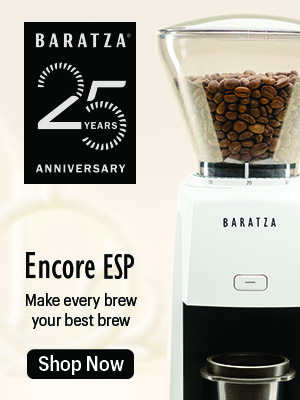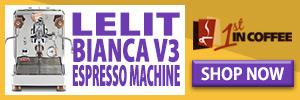When my article titled “Is This the End of the Barista?” was posted on CoffeeGeek back in December 2006, I was piqued by the varied comments made by forum frequenters. At the time, I thought I had made the point that in a saturated – hence more sophisticated – espresso based market, where continually increasing operational expenses along with competition combine to degrade net profits, café owners will seek to reduce the cost of what they can control. Whilst they cannot control the number of competitors out there, they will look at ways of reducing operational expenses whilst maintaining a high level of quality. For in a saturated market, to reduce quality means death to a café; and the biggest expense they can control is not rent, but wages – that of the baristas.
In response, several posters to the article’s thread indicated that the espresso market in the US was progressing along quality lines, and that maybe in Australia we prefer our coffee fast rather than high quality. So, I felt it was appropriate to explain some of the history behind the development of the Australasian market and compare it to that of the US.
History
The post World War II migration of southern Europeans to Australia had a profound effect on the development of a sophisticated espresso market in both Australia and New Zealand.
The espresso machine as we know it, notably the type that drives hot water under pressure through the coffee by use of an electric driven pump, was mass produced from 1948 onwards. This is significant, because it means that emigrants leaving Italy prior to WWII, the majority of whom went to the US, did not have any knowledge of espresso as we know it, produced with this type of machine.
What they knew as “espresso” was effectively a highly concentrated filter-style coffee, made by pushing hot water driven by steam pressure through the coffee grounds. Thus, the American market did not experience early exposure to modern espresso, and given the lack of concentrated pollination of this style of coffee making, espresso has not gained complete national acceptance even today. Whilst I am not denying that there is great espresso to be had in small pockets in the US, it is far from overwhelming in its coverage.
However, from 1947 onwards, most Italian emigrants switched the pattern of their migration to Australia simply because the Australian Government introduced the “£2 ticket”. At the time, passage to the US was an expensive proposition (around $100 USD). By merely pledging to work for 2 years wherever the Australian government put them, an immigrant could gain a virtually free passage to Australia.
The significance was quite palpable.
These people were already exposed to espresso-style coffees in the modern sense. When they arrived in these parts and then spread to all the major cities of Australia and New Zealand, the demand for espresso was born.
It took the onset of the 1956 Melbourne Olympics to create a catalyst for the emergence of cafés.
In preparation for the arrival of the Italian Olympic team, a few enterprising members of the large Italian community in that city (1 million out of 3.5 million total) decided to import the very first espresso machines into Australia and serve authentic Italian espresso. (It is important to note that Italians prefer to drink espresso coffee only, always with sugar and without milk.) These cafés quickly gained popularity amongst the Italian community, hence the tradition of Melbourne being the “coffee” city.
Up until the late 1980s, the espresso market was restricted to pockets of immigrant communities within Melbourne, Sydney, Adelaide, Perth, and Brisbane. The concentration of the population base in these five cities set the framework for the rapid spread of espresso – of a total population of 20 million in Australia, over 13 million live in these cities alone!
Then a natural occurrence began to emerge.
The bulk of the children of these immigrants, first generation Mediterranean Australians, began to reach maturity and look for venues where they could socialise in a non-traditional Australian way. They looked for venues that offered the chance for both sexes to socialise and chat over a drink. And doing this over a cup of coffee was more the norm for these people than socialising over a beer.
Hence, the café sector began to expand rapidly to meet demand.
The explosive growth phase of espresso took hold first in Melbourne around the end of 1980s, then in Sydney around the early 1990s, then Adelaide, Perth, and Brisbane in quick succession. The degree of presence of first generation immigrants in these cities dictated the speed of uptake of cafés.
Only Espresso
What is unique is that, outside Italy, the Australian and New Zealand café markets are the only other 100% espresso-based markets in the world! The US and other countries are dominated by filter style, or brewed, coffee. You cannot give filter coffee away in Australia or New Zealand. Furthermore, the Australian and New Zealand markets are unique in that the espresso based coffees are nearly always served with milk – approximately 98%, compared to 5% milk based coffees in Italy.
As an indication of the highly competitive, sophisticated and quality-driven nature of these markets, we must look at some interesting statistics.
The ratio of espresso machines to population in Australia and New Zealand is approximately 850 people to 1 machine, only bested by Italy. In comparison, in the US, there are roughly 20,000 people per espresso machine. With such a limited number of customers per machine to draw on, cafés in Australia and New Zealand must use quality as the biggest drawcard.
In addition, less than 6% of small businesses in Australia and New Zealand are franchised, as compared to over 40% in North America. The sheer number of franchised stores in North America only serve to reduce the average quality of espresso-based coffee, not improve it.
Defining Quality
I admit that quality is a subjective matter; it all depends on your definition of quality.
Thankfully, I have been exposed to the highest echelons of quality via the many national and international barista competitions I have attended as a judge. I would hope, then, to know what is possible as compared to what is being delivered in the marketplace.
I have travelled extensively in the US, and I cannot say with hand on heart that most cafés there represent the espresso coffee standard of the US Barista Championship or even the World Barista Championship. It is my observation that the US espresso standard (on a national average) is where the Australian and New Zealand espresso markets were 15 years ago.
That means that there is still a lot of room for development.
Third Wave?
Like any market transitioning from infancy, it is only when it reaches maturity that inefficient or ineffective players cluttering the market begin to “hit the wall.” They simply have to pick up their game with quality and speed to maintain profit margins. And whilst the “third wave of coffee” is a term being spoken of so liberally in North America, it has been in existence as an operational necessity for some time in Australia and New Zealand.
The rapid emergence of barista training schools in the last five years within the Australian and New Zealand market is but one primary example of how these retail coffee markets have reached maturation, thereby putting pressure on retailers to deliver on quality.
National Training Standard
In fact, since 2004 there has existed a compulsory minimum industry national training standard for espresso in Australia and New Zealand. The US, on the other hand, has had to rely on the SCAA or other organisations to set a voluntary kind of “national” standard.
In Australia and New Zealand, cafés are required to pick up on quality to create a point of difference in the market place. The independent nature and fierceness of competition necessitates quality improvement merely to survive as a café.
And the competitive advantage gained by individual businesses by improving quality is brief at the retail end. Since information travels so fast, and the concentration of populations in Australia and New Zealand are confined to only a few cities, it is not long before everyone in the retail café market understands the benefit of any recent improvements, and implements these changes almost immediately. In fact, it is my observation that the New Zealand market is the more competitive of the two, due to fewer large cities without the tyranny of distance – which usually serves to slow down transfer of information. On the other hand, in North America, competition at the highest level is sporadic, given the huge spread of population bases.
Evolved Palates
Additionally, the coffee products and methodologies used to create a profitable business in the early stages of a market’s development simply do not allow for success and profitability in the same, but more mature, market. Generally, as a market matures, consumer expectations and palates mature proportionally. Quality of product and processes must evolve to meet expectations.
Where coffee in these parts was once all about Italy, the coffee consumer in Australia and New Zealand has long moved away from Italian brands designed to deliver a smooth, non-offensive and mellow flavour as an espresso (without milk).
The reason is taste.
Combined with a cup of milk in an 8 oz or 12 oz cup, Italian coffees do not deliver on the expectations of a more mature consumer palate. Another aspect to imported Italian coffee is that, by virtue of being a fresh food product, they are in various states of decomposition once they get to overseas markets, thereby suffering diminished flavour and potency with milk. And when roasted coffee is in this state, there are noticeable undesirable and negative traits left on the palate – highly undesirable when compared to easily available, locally roasted, and fresher product. This has led to the emergence of a plethora of local and small boutique roasters. New entrants arrive weekly – and only serve to chip away at the traditional market established by the large coffee suppliers and to intensify the quality debate via proof of product.
And in the last five years, the drive for a point of difference in the café market has led to the emergence of microroaster cafés – a solid trend in the café scene. Intensity of competition is providing the impetus here. Alternatively, a large proportion of cafés are demanding, and getting, tailored blends for their establishments – another trend which has been going on for some time.
Whilst I have no real figures on the number of roasters per capita, the assumption is around 400 to 500 in Australia and New Zealand – of a total population base of 24 million people!
So rather than the bulk of establishments – 40% in North America – rushing to the middle ground to capture the bulk of consumers with a generic product designed to be accessible everywhere, cafés in Australia and New Zealand have gone the other way. Their focus is on raising the quality bar – on product, processing, service, shop design, and other features – all adding up to an aggressive and continuing maturity of market.
No wonder franchise chains are doing it tough in the consumers’ mind!























